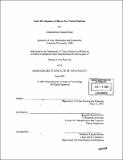Joint development of mixed-use transit stations
Author(s)
Karp, Jordan Robert Samuel, 1972-
DownloadFull printable version (15.36Mb)
Other Contributors
Massachusetts Institute of Technology. Dept. of Urban Studies and Planning.
Advisor
Kenneth Kruckemeyer.
Terms of use
Metadata
Show full item recordAbstract
If rail transit systems are to become a viable means of transportation throughout American cities, urban land use patterns must support the development and use of transit. Transit-oriented development, in which mixed land uses are clustered around transit stations in dense concentrations, offers a means of encouraging transit use and decreasing reliance on automobiles in urban settings. Transit agencies have the opportunity to contribute to this development pattern by incorporating mixed-use transit facilities into their rail systems. These facilities, typically developed through public-private partnerships, incorporate other uses into sites with transit stations. They increase activity around the station and attract additional development to the area. Unfortunately, many transit agencies have little experience with developing mixed use facilities and are reluctant to undertake such projects. The agencies are intimidated by the additional design, financial, and administrative requirements of the development process. The goal of this thesis is to generate a set of principles that provides transit agencies with a foundation of knowledge for approaching mixed-use and joint development projects. The proposed principles strive to maximize the benefits generated by the facilities and increase the likelihood of such development activity occurring successfully. Three aspects of the development process are chosen for attention: site selection, basic elements of facility design, and implementation. The thesis begins with a review of design and development theory and past development strategies to identify the key issues relevant to these types of projects. A set of principles targeting the three aspects of the development process is proposed, based on the issues identified in the research. The principles are then applied to transit agencies and station sites in two cities: San Juan, Puerto Rico and Chicago, Illinois; evaluations and recommendations are made for each city. The application to real world situations allows the principles to be tested and assessed. The thesis concludes with a review of the results for these cities, a critique of the proposed principles, and suggestions for further research on the topic.
Description
Thesis (M.C.P.)--Massachusetts Institute of Technology, Dept. of Urban Studies and Planning, 2003. Includes bibliographical references (p. [143]-[147]).
Date issued
2003Department
Massachusetts Institute of Technology. Department of Urban Studies and PlanningPublisher
Massachusetts Institute of Technology
Keywords
Urban Studies and Planning.